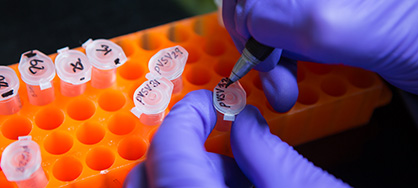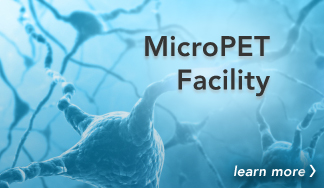Research Highlights
Modestly Reducing Level of Key Protein Can Cause Leukemia
September 11, 2015—(BRONX, NY)—Hematopoietic stem cells (HSCs) are responsible for forming all the cell types normally found in the blood. HSCs differentiate over the course of several cellular stages, ultimately maturing into “adult,” non-dividing blood cells. But sometimes, HSC maturation is arrested at an early, still-dividing stage, resulting in leukemia and other cancers of the blood.

Ulrich Steidl, M.D., Ph.D.In acute myeloid leukemia (AML), HSCs undergo mutations that turn them into pre-leukemic stem cells—which may then develop additional mutations that transform them into malignant leukemia stem cells. These leukemia stem cells divide uncontrollably and produce the overabundance of white cells that characterize AML. The existence and clinical importance of pre-leukemic stem cells was definitively proven in recent years, but very little was known about the molecular mechanisms that form them and propel them to develop into fully transformed malignant leukemia stem cells. That knowledge gap has impeded efforts to therapeutically target pre-leukemic stem cells.
The maturation of HSCs is one of numerous cellular processes directed by transcription factors—proteins that bind to genes, orchestrating which ones will be expressed and in what sequence. Ulrich Steidl, M.D., Ph.D., associate professor of cell biology and of medicine and the Diane and Arthur B. Belfer Faculty Scholar in Cancer Research, and colleagues have found for the first time that modest reduction in levels of the transcription factor PU.1 can trigger a human cancer—in this case, AML. Their study, published in the September 7 online edition of Nature Medicine, also shows that mutations in non-protein-coding regions of DNA—which often cause just modest dips in protein levels—may actually play major roles in causing AML and other cancers. Such mutations in non-coding DNA are commonly encountered in cancer genomics studies but have been largely ignored.
PU.1 is a “master regulator,” meaning it is indispensable for the proper functioning of HSCs and their differentiation into mature blood cells. In mice, moderately reduced PU.1 levels fail to cause AML. Instead, previous studies had suggested that nearly complete loss of PU.1—on the order of 80 percent to 100 percent reduction in PU.1 expression—is required. AML patients commonly have modest decreases in PU.1 levels or activity, but it was unclear whether such decreases indeed played a role in turning HSCs into pre-leukemic stem cells. Dr. Steidl and colleagues hypothesized that minimal reduction in PU.1 expression might actually be important in causing HSCs to cause cancer in some patients, particularly in the context of acquired mutations that accumulate as people get older. (The median age of diagnosis for AML is 67.)
So the researchers generated a mouse model of AML in which levels of the transcription factor PU.1 were decreased by a modest 30 percent. That involved causing a heterozygous deletion (i.e., only one member of the gene pair was deleted) in a regulatory (non-coding) stretch of DNA known to be an upstream enhancer of the PU.1 gene’s transcription. And since evidence suggested that impaired DNA mismatch repair allows for the accumulation of mutations relevant to AML, the mouse model carried a homozygous deletion of the gene Msh2, which encodes a protein crucial for repairing DNA mutations.
AML developed in 70 percent of these mice. Moreover, the disease resembled human AML in many respects including elevated white blood cell counts, rapid increase in white blood cells shortly before death, severe enlargement of the spleen and liver and the shape of “blast” cells typical of AML. (“Blasts,” short for myeloblasts, are immature blood-forming cells not normally found in blood.). In addition, mice in the early stages of this disease had disturbed stem cell function and developed a condition resembling myelodysplastic syndrome (MDS), which frequently precedes development of AML in humans.
Since AML is largely a disease of aging, the researchers looked at whether PU.1 levels decline as people get older, setting the stage for AML in some individuals. Comparing PU.1 levels in HSCs from healthy blood donors older than 65 and in people aged 20 to 35, the researchers found slightly but significantly decreased expression levels of PU.1 in the older people.
To further examine PU.1’s relevance to human AML, the researchers examined whether reductions in PU.1 expression altered the transcription of similar genes in their mouse model of AML and in people who have the disease. They divided patients described in two published gene expression studies into two groups: “PU.1 lower” and “PU.1 higher” patients. Many of the same genes that were aberrantly expressed in the mice were also aberrantly expressed in the “PU.1 lower” patients. By contrast, there was little overlap between aberrantly expressed mouse genes and aberrantly expressed genes in the “PU.1 higher” patients.
The authors concluded that the commonly observed modest impairment of PU.1 activity in human AML may be a key event in initiating AML in many patients—altering the fate of HSCs and sensitizing them to further malignant transformation. Other key transcription factors known to undergo small changes in expression may also merit more attention, the authors noted, since they may play critical—but thus far unappreciated—roles in the early stages of tumor development.
The lead author of the study was Britta Will, Ph.D., an instructor of cell biology at Einstein.
Posted on: Friday, September 11, 2015



Tablet Blog